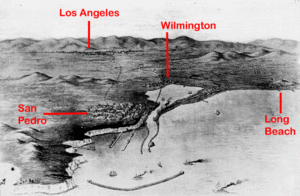Siege of Los Angeles
| Siege of Los Angeles | |||||||
|---|---|---|---|---|---|---|---|
| Part of the Mexican–American War | |||||||
 San Pedro Bay, 1900. | |||||||
| |||||||
| Belligerents | |||||||
|
|
| ||||||
| Commanders and leaders | |||||||
|
Robert F. Stockton John C. Fremont Archibald H. Gillespie |
Jose Maria Castro José María Flores José Antonio Carrillo Andrés Pico | ||||||
| Strength | |||||||
| 48[1]:183 | 150 militia[1]:184 | ||||||
| Casualties and losses | |||||||
| 0 | 0 | ||||||
The Siege of Los Angeles was a military response by armed Californios to the occupation, which had begun August 13, 1846, by the United States Marines of the Pueblo de Los Angeles during the Mexican–American War.[2]
Background
Following the Battle of Monterey, the Americans held northern California but General Jose Maria Castro and Governor Pio Pico planned resistance in the south around the Los Angeles area.[1]:172 Commodore Robert F. Stockton arrived at Monterey Bay aboard the Congress on July 15 and took over command from John D. Sloat.[1]:170 Stockton accepted the Bear Flag revolutionaries, under the command of Major John C. Frémont, as the California Battalion.[1]:173 Stockton then garrisoned Sonoma, San Juan Bautista, Santa Clara, and Sutter's Fort.[1]:173 Stockton's plan for dealing with Castro was to have Commander Samuel Francis Du Pont carry Fremont's men in the Cyane to San Diego to block any movement southwards, while Stockton would land a force at San Pedro which would move overland against Castro.[1]:174 Fremont arrived at San Diego on July 29 and reached San Pedro on August 6 aboard the Congress.[1]:174
Occupation
Upon holding a council of war, Castro decided to leave California, heading to Sonora with Pico and a few supporters on August 11, while the rest of his force retired to Rancho San Pascual.[1]:176
On August 13, 1846, Stockton led his column into town, followed by Fremont's force a half-hour later.[1]:176 On August 14, the remnants of the California army surrendered.[1]:176
Resistance
Stockton established a garrison of forty-eight men under Capt. Archibald H. Gillespie and departed in September[1]:177,183 His men, however, were undisciplined in an area with pro-Mexican feelings.[1]:183
Siege
On September 23, twenty men under the command of Cerbulo Varela exchanged shots with the Americans at Government House, which ignited Los Angeles.[1]:184 On September 24, 150 Californios, organized under José María Flores, a Mexican Officer who remained in California, at Castro's old camp at La Mesa.[1]:184 Gillespie's forces were effectively besieged, while Gillespie sent Juan "Flaco" Brown to Commodore Stockton for help.[1]:184
Gillespie's men retreated to Fort Hill on September 28, but without water, they surrendered the next day.[1]:184 Terms called for Gillespie's men to leave Los Angeles, which they did on September 30, 1846, and boarded the American merchant vessel Vandalia.[1]:184
Flores quickly cleared remaining American forces in southern California.[1]:184
See also
- Pueblo de Los Angeles
- List of conflicts in the United States
- Battles of the Mexican–American War
- Captain John Strother Griffin (1816–1898), physician during the battle
References
Further reading
- California History, Bancroft - http://www.1st-hand-history.org/Hhb/HHBindex.htm
Coordinates: 34°03′08″N 118°14′38″W / 34.0522°N 118.2440°W